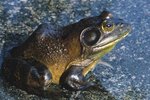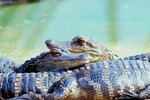
Amphibians typically breed in freshwater, laying eggs that hatch into aquatic larvae and then undergo metamorphosis into adult forms that live mainly on land. This three-stage life cycle has many environments, and some amphibians, including a few frogs and toads, the fire salamander and several species of caecilians, are viviparous: They produce young within their bodies rather than in eggs, and they give birth to live young.
Caecilians
Caecilians look like large worms or snakes, with long, limbless bodies and heavily boned, pointed heads that enable them to burrow into soil. Around 165 species of caecilians live in subtropical and tropical rainforests. Some species lay their eggs in water, some in soil; others, such as the large, terrestrial Mexican caecilian and the aquatic cayenne caecilian, give birth to fully metamorphosed live young. The embryos are nourished with uterine milk -- secretions they scrape off the walls of their mothers' oviducts.
Frogs
A few species of frogs, members of the African genus Nectophrynoides, retain the fertilized eggs in the females' oviducts, where they develop and are born as miniature frogs. In Australia, gastric brooding frogs swallow their fertilized eggs, which grow into tadpoles and frogs in the stomachs of the female frogs. This can take up to eight weeks; the female frogs can't eat during this time, as their gastric secretions stop to prevent their young from being digested. When fully developed, the miniature frogs hop out of their mothers' mouths. With Darwin frogs, the males swallow the fertilized eggs, and the tadpoles develop in their vocal sacs.
Toads
The Western Nimba toad from the Mount Nimba region of Guinea is viviparous. The eggs are fertilized before the female toads go underground for the dry season from October to April. They re-emerge as the rains start but ,since gestation lasts nine months, it will be June or July before the toads' fully metamorphosed froglets are born.
Midwife toads are not viviparous, but the males carry strings of fertilized eggs attached to their hind legs, keeping them safe, and keeping them moist by dipping them in water. After about a month the eggs are ready to hatch and the males deposit them in shallow water. Male surinam toads, after fertilizing the eggs, attach them to the backs of females and skin grows over the eggs to form a pouch where the young develop. They eventually break out of holes in their mothers' skin as miniature toads.
Salamanders
Many species of salamanders, which have long, thin bodies and long tails, lay their eggs on land. The black-and-yellow-colored fire salamanders of central and southern Europe retain their eggs in the oviduct; the developing larvae are nourished by the egg yolk but some eat their siblings either as eggs or larvae. The females give birth to well-advanced larvae, releasing clutches of 12 to 50, into ponds and streams. Sometimes, at higher altitudes, the young stay in the oviducts until they have metamorphosed into adult forms.
References
- Reptiles and Amphibians; Mark O'Shea and Tim Halliday
- Amphibiaweb: Amphibian Facts
- Emploratorium Frogs: The Amazing, Adaptable Frogs
- Amphibiaweb: Nimbaphrynoides occidentalis Western Nimba Toad
- Animal Diversity Web: Salamandra salamandra
Photo Credits
-
Hemera Technologies/PhotoObjects.net/Getty Images



